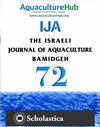Effects of salinity and alkalinity on growth and survival of all-male giant freshwater prawn (Macrobrachium rosenbergii De Man, 1879) juveniles
IF 0.5
4区 农林科学
Q4 FISHERIES
引用次数: 0
Abstract
All-male giant freshwater prawns (AMGFPs) have been a popular crop cultivated in the Mekong Delta, Vietnam, due to their proven production efficiency compared to all-female or mixed-sex prawn cultures. However, the crucial water quality factors impacting AMGFP aquaculture efficiency have yet to be elaborately investigated. Two separate experiments were randomly arranged with three replicates to evaluate the effects of salinity or alkalinity on the growth and survival of AMGFP juveniles during the grow-out period. The results show that the prawn survival rate in the salinity range of 0–15‰ varied from 66.1 to 74.8% and in a salinity range of 0–5‰ was relatively low compared to the range of 10-15‰; however, the difference was not significant among salinities after 90 days of culture (p > 0.05). All the prawn growth performance parameters significantly decreased with increasing salinities of 0, 5, 10, and 15‰ after 30, 60, and 90 days of culture (p < 0.05). Notably, the prawn yield did not significantly differ between salinities of 0 and 5‰ (p > 0.05), and both were significantly higher than those at salinities of 10 and 15‰ (p < 0.05) after 90 days of culture. In addition, the survival rate reached 82.5–84.4% and did not significantly differ among alkalinities of 80, 100, 120, 140, and 160 mgCaCO3 L−1. However, the growth performance parameters and yield of AMGFPs at an alkalinity of 160 mg L−1 were significantly higher than those at lower alkalinities (80, 100, 120, and 140 mg CaCO3 L−1) after 90 days of culture. Therefore, it is recommended that a salinity range of 0–5‰ and alkalinity of 160 mgCaCO3 L−1 is optimal for the growth-out culture of AMGFP juveniles.盐度和碱度对罗氏沼虾(Macrobrachium rosenbergii De Man, 1879)幼虾生长和存活的影响
在越南湄公河三角洲,全雄性巨型淡水对虾(amgfp)一直是一种受欢迎的作物,因为与全雌性或混合性别对虾养殖相比,它们的生产效率得到了证实。然而,影响AMGFP养殖效率的关键水质因素尚未得到详细研究。随机安排2个单独实验,3个重复,研究盐度和碱度对AMGFP幼鱼生长和成活率的影响。结果表明:0 ~ 15‰盐度范围内对虾存活率为66.1 ~ 74.8%,0 ~ 5‰盐度范围内对虾存活率较10 ~ 15‰低;培养90 d后,各盐度间差异不显著(p < 0.05)。在培养30、60和90 d后,各对虾生长性能参数均随盐度0、5、10和15‰的升高而显著降低(p < 0.05)。培养90 d后,0‰和5‰的对虾产量差异不显著(p < 0.05),均显著高于10‰和15‰的对虾产量(p < 0.05)。此外,在80、100、120、140和160 mgCaCO3 L−1碱度下,存活率无显著差异,达到82.5-84.4%。然而,在160 mg L−1碱度下,培养90天后,amgfp的生长性能参数和产量显著高于较低碱度(80、100、120和140 mg CaCO3 L−1)下的amgfp。因此,建议盐度范围为0-5‰,碱度为160 mgCaCO3 L−1是AMGFP幼鱼生长培养的最佳条件。
本文章由计算机程序翻译,如有差异,请以英文原文为准。
求助全文
约1分钟内获得全文
求助全文
来源期刊
CiteScore
0.90
自引率
16.70%
发文量
49
审稿时长
3 months
期刊介绍:
Information not localized

 求助内容:
求助内容: 应助结果提醒方式:
应助结果提醒方式:


